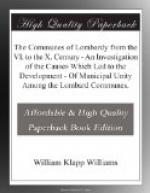The next forward step in the advance of the bishops to temporal power was made probably about the time of Charles the Bald; though under his two immediate predecessors, Lothaire[91] and Lewis II.,[92] we already see indications of an extension of the quality of exemption to include freedom from the payment of all public dues and the bearing of all public burdens.[93] It was precisely the introduction of this element of exemption from public burdens which marked the change in the nature of the immunities granted from the time of Charles the Bald, down to the period when the element of jurisdiction and real temporal power was introduced under Guido and Berenger. Up to this time, the grounds on which similar charters had been sought had been protection from the oppression of the counts, and had resulted, as we have seen, in the granting of simple charters of protection which were of no very great significance. But now it is exemption from public burdens, etc., that is made prominent, in addition to a complete severance from all jurisdiction and control of the secular power of the civitas in which the bishop’s see and domains are situated. That this concession also was sought by the bishop on the plea of protection for his dependents from oppression and exaction, does not diminish its importance; for it is easy to see that the line which separates recognized right of protection from recognized right of jurisdiction is one easily effaced, and defense from the tyranny of a foreign power can with little difficulty be transformed into domination by the professed defender.
That this was the order of development consequent on these changes is proved by the temporal dominion gained by the bishops in the next century; and the steps of its growth marked by numerous immunities granted by Charles the Bald, Karloman[94] his successor, and Charles the Fat, the last of the Carlovingians in Italy. As a good example of the complete development of this advance gained by the bishops, I will mention a charter given by Charles the Fat to John, bishop of Arezzo, in the year 879, in which he confirms to him all the property and the rights of that see, and takes him under his protection, “sub immunitatis suae defensione”: he then goes on to explain what this term meant, giving a full account of the extent to which a bishop’s property was exempted from the jurisdiction of the judex publicus, and protected from the imposition of burdens and exactions.[95]




